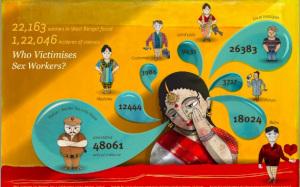And ye shall know the truth, and the truth shall make you free. - John 8:32
I recently realized that because the prohibitionists have a set of stock lies they can repeat in an article or internet comment, someone trying to refute them is forced to link to a number of different sources to debunk those lies. In order to make things easier, I’ve decided to consolidate responses in one place; in a few days I’ll replicate this column as a static page, to which I can add new lies which may appear and new statistics with which to debunk them. This column only covers factual claims; emotional arguments of the “no little girl dreams of being a prostitute” variety are covered in “Amazingly Stupid Statements”.
 LIE: The average age at which a woman enters prostitution is 13.
LIE: The average age at which a woman enters prostitution is 13.
TRUTH: If this were true, there would have to be huge numbers of toddler-prostitutes to balance the many, many women who start later in life, such as to support themselves after divorce. Even underage prostitutes start at an average of 15-16, and only 15% of teen hookers (themselves a small minority of all sex workers) enter at an age below 13. A conservative estimate for the average age at which women enter the trade is 25. The “average debut at 13” lie was a purposeful distortion by anti-sex crusader Melissa Farley, who misrepresented the average age of first noncommercial sexual contact (which could include kissing, petting, etc) reported by underage girls in one 1982 study as though it were the age they first reported selling sex; the actual average age at which the girls in that study began prostitution was 16.
LIE: The average age of death for a prostitute is 34.
TRUTH: That figure was derived from a 2003 study which examined all of the reports of murdered street workers in Colorado Springs from 1967-1999, and discovered that the average age of death of those victims was 34. In other words, nobody who wasn’t murdered was included in the figure. It’s like using the average age of dead soldiers in a war to proclaim “the average man who joins the military dies at 21”.
LIE: The demonstrable problems with legalization schemes in places like Nevada and the Netherlands constitute an argument in favor of criminalization.
TRUTH: The demonstrable problems with those legalization schemes constitute an argument in favor of decriminalization. No sex worker rights organization in the world favors the Dutch or Nevada models, precisely because they do give rise to a host of problems which are prevented by treating sex work as work.
LIE: 85% of prostitutes report childhood sexual abuse.
TRUTH: The original source for this claim was a 2004 study of incarcerated street workers which actually claimed that 45% reported sexual abuse and 85% physical abuse. Furthermore, there are serious methodological problems with the study, which is typical when biased researchers use an unrepresentative convenience sample and then extrapolate the results to a much larger population with which it does not correlate to any meaningful extent.
LIE: “End Demand” tactics are an effective means of reducing prostitution.
TRUTH: Economic analysis demonstrates that “end demand” tactics increase the number of sales of sex, especially at the street level.
LIE: ”Human trafficking” is the world’s second most profitable criminal enterprise (or the third most, or most recently the most).
TRUTH: This myth originated in a UNODC meeting where Kevin Bales (see “27 million” below) said, “…it’s impossible to answer that question. If I had to guess I would say it was third…” Ann Jordan surmised that the original source of the myth (later revealed as Bales) was probably thinking about smuggling, certainly a more credible candidate for the position.
 LIE: Most of the violence to which sex workers are subjected is at the hands of clients or pimps.
LIE: Most of the violence to which sex workers are subjected is at the hands of clients or pimps.
TRUTH: Most of the violence suffered by sex workers in regimes where the work is fully or partially criminalized is at the hands of police.
LIE: Most or nearly all prostitutes are controlled by pimps and forced to work.
TRUTH: In nearly every stable modern society, the rate of coercion for adult prostitutes is about 2% or less, and for underage ones about 8-10%; this is roughly the same as the rate of non-sex-working women who report an abusive or controlling boyfriend or husband.
LIE: Most prostitutes are driven to it by financial need, and 9 out of 10 prostitutes would like to exit prostitution immediately.
TRUTH: These statements are probably true, but if there is any normal job (not an elite career occupied by a tiny fraction of the population) to which they do not apply, I’d like to know what it might be. What makes this a lie is the pretense that it applies to sex work to a higher degree than to other jobs, which it does not; one Australian study found that half of all prostitutes ranked their work as a “major source of satisfaction” in their lives, and 70% said they would definitely choose prostitution again if they had their lives to live over.
LIE: Most prostitutes are “recruited” into the work by pimps.
TRUTH: Most adult sex workers start due to pragmatic concerns, and most underage ones either think of it on their own or are recruited by friends.
LIE: Most prostitutes suffer symptoms of Post-Traumatic Stress Disorder.
TRUTH: This is another of Melissa Farley’s pet lies. She claims to be able to diagnose PTSD with a 15-minute self-administered questionnaire, despite the fact that the National Center for PTSD states that “brief, single-item, closed-ended questions for each PTSD symptom are…no more valid for making a diagnosis than self-report measures…Proper assessment of PTSD is complex…” In short, she is not qualified to diagnose this condition, and her method would be quackery even if she were.
LIE: Nearly all men buy sex OR a small, pathological group of men buys sex.
TRUTH: Though a slight majority of men have paid for sex at least once in their lives, about 20% of them do it “occasionally” (several times per year) and 6% “frequently” (several times per month).
LIE: 100,000-300,000 children are “trafficked” every year in the United States.
TRUTH: That myth is a distortion of an absurd estimate from the Estes & Weiner study of 2001, which estimated that number of “children, adolescents and youth (up to 21) at risk of sexual exploitation”. “Sex trafficking” was the least prevalent form of “exploitation” in their definition; other things they classed as “exploitation” included stripping, consensual homosexual relations and merely viewing porn. Two of the so-called “risk factors” were access to a car and proximity to the Canadian or Mexican border. When interviewed by reporters in 2011, Estes himself estimated the number of legal minors actually abducted into “sex slavery” as “very small…We’re talking about a few hundred people.”
LIE: Prostitutes only do the work because they have no meaningful choices.
TRUTH: 93% of escorts say they like their work for the money, 72% for the independence and 67% for meeting people. And a 2011 study demonstrated that most American escorts are women with “high opportunity cost”, in other words those who have many other meaningful options.
LIE: Prostitutes spread disease.
TRUTH: Only about 3-5% of all STIs can be attributed to either side of a sex work transaction, and the rates of infection among professionals are much (often dramatically) lower than among promiscuous amateurs.
LIE: Prostitution destroys the self-esteem of women involved in it.
TRUTH: Though only a small fraction of street workers report an increase in self-esteem after entering harlotry, they represent less than 15% of all prostitutes. 97% of escorts in one study reported an increase in self-esteem, compared with 50% of Nevada brothel workers; another study found that 75% of escorts felt their lives had improved since starting the work, 25% reported no change and 0% said their lives were worse. Anyone who has ever personally known any sex workers of any kind knows that if anything, their self-esteem is often too high.
LIE: Prostitution is associated with crime.
TRUTH: Criminalization is associated with crime. When “authorities” criminalize a consensual activity, they shouldn’t be too surprised when criminals are then attracted to it. When’s the last time you heard of anyone arrested for bootlegging or rum-running?
LIE: “Sex trafficking” increases when prostitution is legalized.
TRUTH: This claim is based on the deeply-flawed Neumayer, Cho and Dreher study, which failed to even define the term “trafficking” in any way which would allow statistical comparison. The lie was further developed by a report in Der Spiegel which used figures for exploitation among illegal prostitutes to argue against legalization. In any legalization regime, those sex workers who are defined as being outside the legal structure (i.e. still criminal) are always those at greatest risk of violence and exploitation; to the extent that “trafficking” actually exists, it is generally the illegal nature of sex work which supplies the greatest tool for coercion. In the decriminalized structures of New Zealand and New South Wales, coercion is virtually nonexistent.
LIE: Sex work causes rape.
TRUTH: The evidence suggests that sex work of all kinds actually decreases the rates of rape, sexual assault, divorce and several other sex-related social ills.
LIE: The Swedish model has dramatically reduced prostitution and sex trafficking in Sweden.
TRUTH: The Swedish model cannot be shown to have had any effect on rates of prostitution at all, though it has made the lives of sex workers much more difficult and dangerous. Norwegian studies demonstrate that their version of the law has increased sex trafficking and the number of prostitutes, and also promoted pimping.
LIE: There are 27,000,000 people enslaved in the world today.
TRUTH: That number was developed by a “trafficking” fanatic named Kevin Bales using media reports multiplied by arbitrary numbers of his own devising; the more the hysteria, the higher the number of articles and thus the higher Bales’ number grows. “Trafficking” estimates are all over the map; the official UNODC estimate is less than a tenth as much (2.4 million), and even with vague, loose and ever-expanding definitions of “trafficking” the office has evidence for only about 40,000 in the entire world.
LIE: A very large fraction of sex workers are below 18.
TRUTH: In legal forms of sex work, virtually none are; in illegal forms the fraction is still very small. Only about 3.5 % of prostitutes in Western countries are under 18.
That’s all I can think of for now; post any others you’ve seen in the comments and I’ll add them to the static page.
